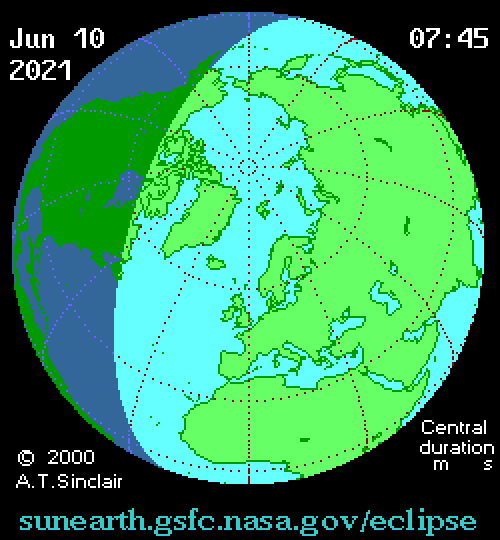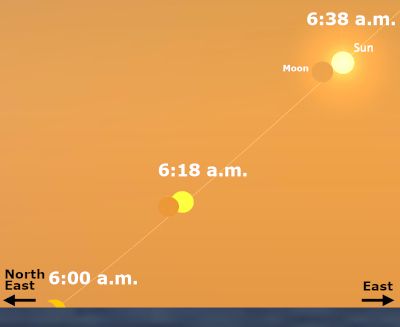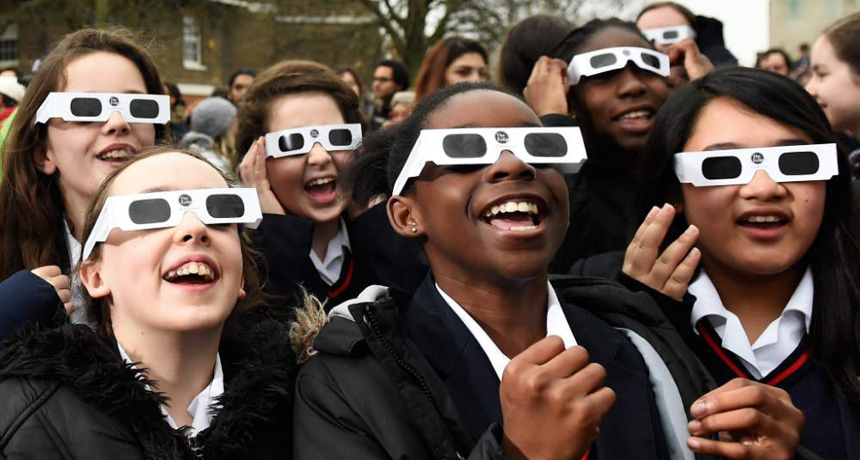More Information about the 2021 Solar Eclipse
 On Thursday, June 10, the Moon will slowly slide across the face of the Sun in a solar eclipse. The darkest part of the Moon's shadow will race across the northern parts of Canada,
Greenland, and Alaska. People along this line will see the Moon completely cover the
Sun in an annular eclipse. Toledo, Ohio, is not in the deepest shadow so we will see a partial eclipse, with
the Moon covering part of the Sun.
On Thursday, June 10, the Moon will slowly slide across the face of the Sun in a solar eclipse. The darkest part of the Moon's shadow will race across the northern parts of Canada,
Greenland, and Alaska. People along this line will see the Moon completely cover the
Sun in an annular eclipse. Toledo, Ohio, is not in the deepest shadow so we will see a partial eclipse, with
the Moon covering part of the Sun.
 The eclipse is a long event since we are watching the Moon slowly move in its orbit
around Earth. In Toledo the deepest part of the Moon's shadow will pass by us before
sunrise. On June 10 sunrise is 5:59 a.m. Look to the northeast to find the rising
Sun, and you will see it half-covered by the Moon. As the Sun rises you will see more
of it uncovered. The Moon is slowly heading eastward in its orbit, so it will look
like the Sun is rising faster than the Moon. The eclipse will end at 6:38 a.m. when
the Sun is about 5 degrees above the horizon.
The eclipse is a long event since we are watching the Moon slowly move in its orbit
around Earth. In Toledo the deepest part of the Moon's shadow will pass by us before
sunrise. On June 10 sunrise is 5:59 a.m. Look to the northeast to find the rising
Sun, and you will see it half-covered by the Moon. As the Sun rises you will see more
of it uncovered. The Moon is slowly heading eastward in its orbit, so it will look
like the Sun is rising faster than the Moon. The eclipse will end at 6:38 a.m. when
the Sun is about 5 degrees above the horizon.
Given the early hour and the difficulty viewing the Sun, as well as potential clouds, the Department of Physics and Astronomy will not be holding a viewing event.

If you are viewing the eclipse on your own, please do so safely so that you may enjoy future eclipses (like 2024 when the Moon's shadow passes very close to Toledo!). Even when 90% of the Sun is blocked, the sunlight is intense enough to damage your eyes if you stare at it too long. To safely stare at the Sun you need to view it through material that blocks most of the light, like eclipse glasses or welder's glass #14. Sunglasses or even multiple pairs of sunglasses do not block enough light to be safe.

If you have a small mirror you can reflect an image of the Sun and project it onto a wall or the ground for safe viewing. You can cover a larger mirror with paper and cut a dime-sized hole in the paper (make it a triangle shape just for fun!) and you can reflect an image of the Sun on a surface 30 feet away. It helps to rest the mirror on something like clay so you can adjust it as the Earth rotates and to make sure the surface is in the shade so you can see all the detail of the Sun.
You can also make an image of the Sun using pinhole projection. A small hole will project the image of the Sun. You can poke a hole in paper, make a grid with your fingers, use a colander from your kitchen, or look at the shadow of tree leaves. You can experiment with whether the shape of the hole affects the shape or appearance of the image of the Sun.


